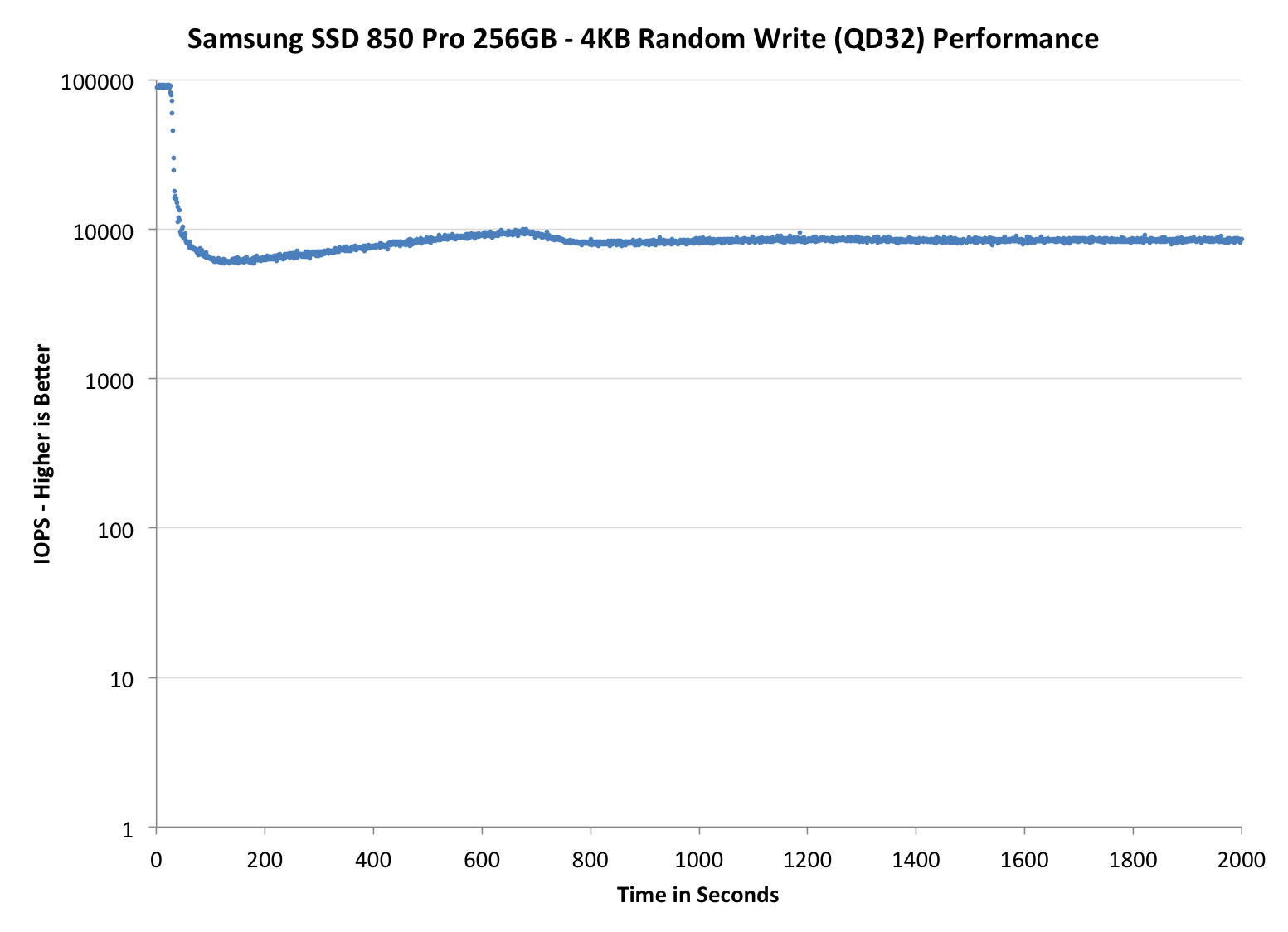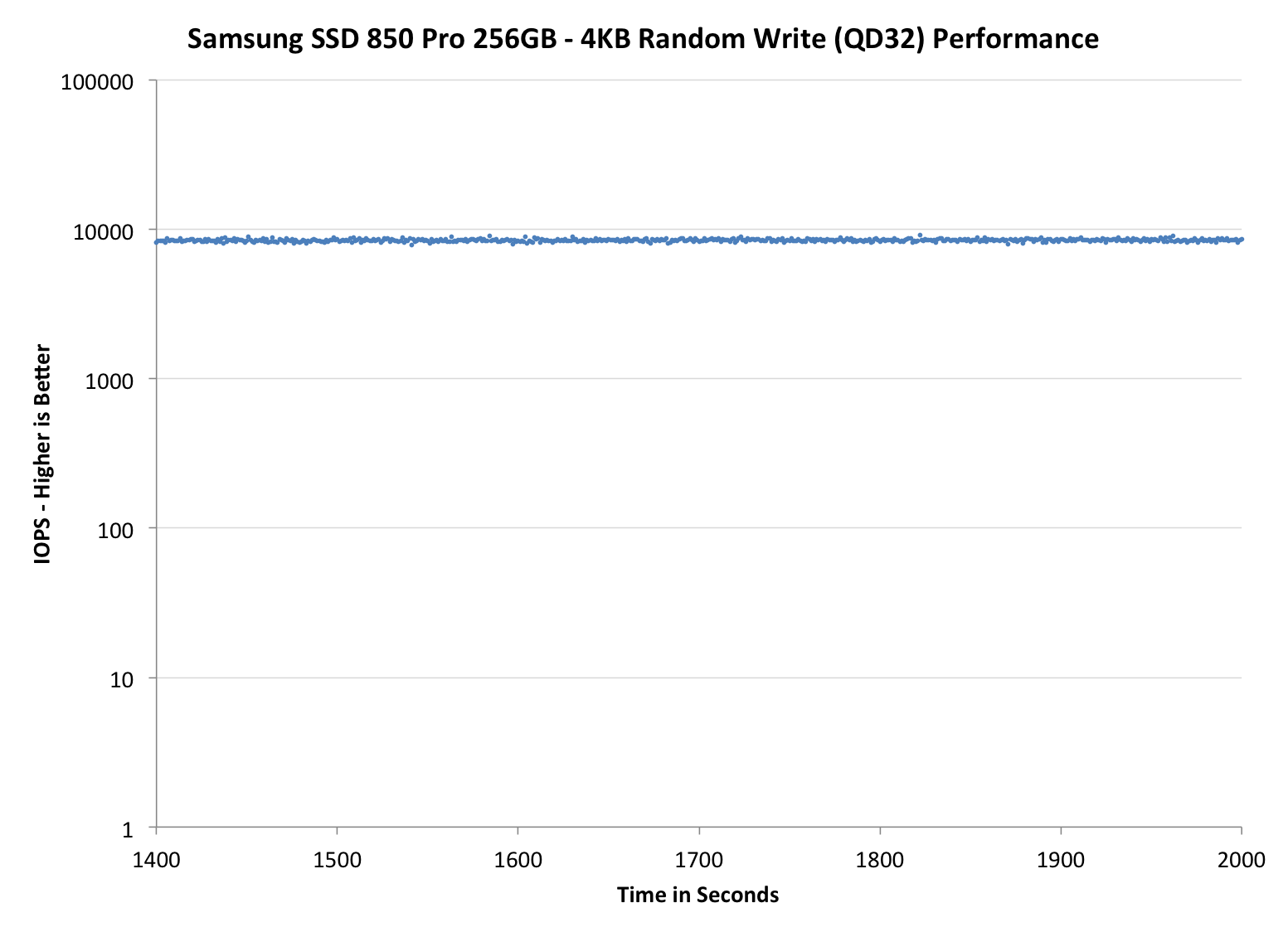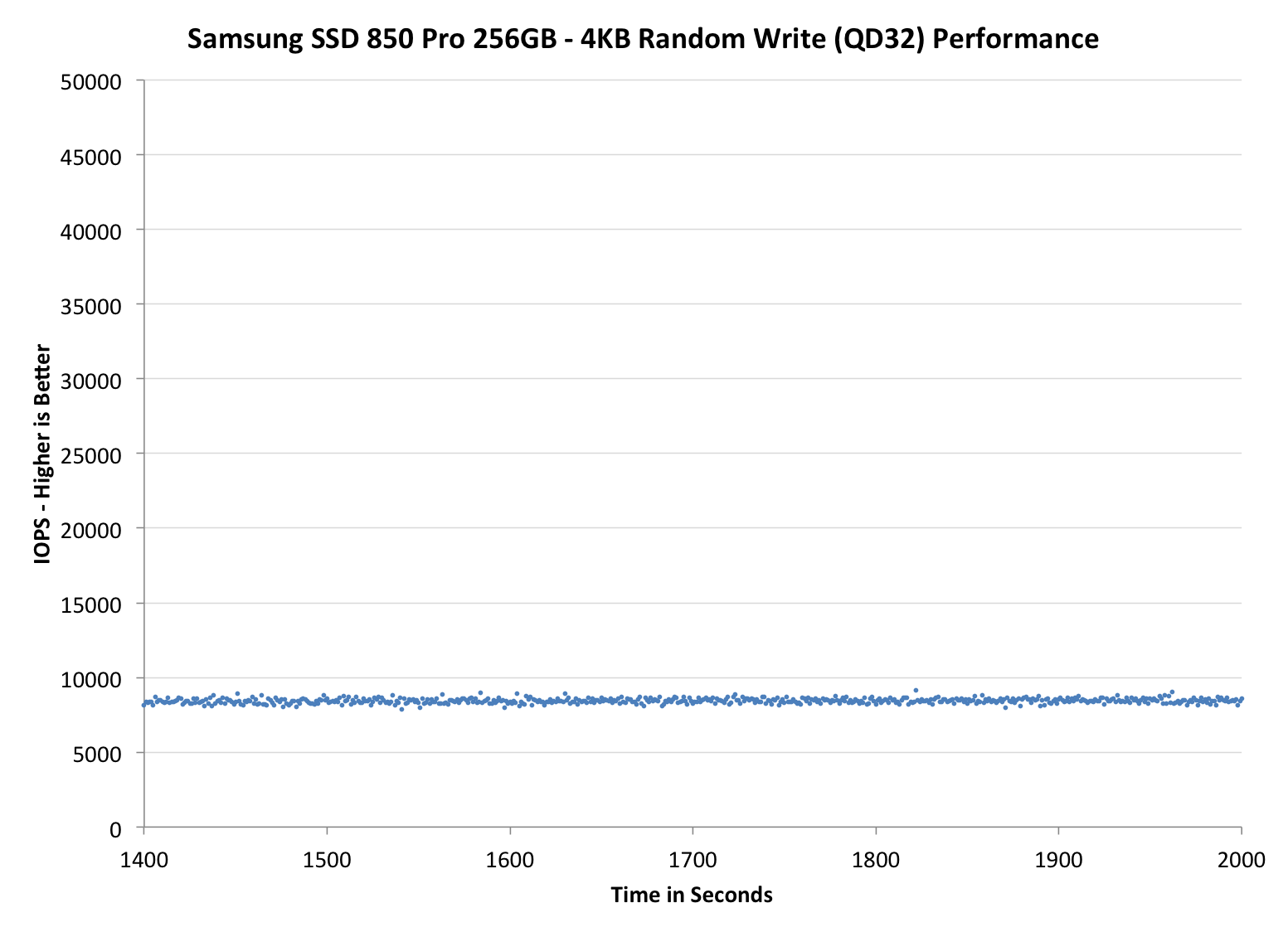Samsung SSD 850 Pro (128GB, 256GB & 1TB) Review: Enter the 3D Era
by Kristian Vättö on July 1, 2014 10:00 AM ESTPerformance Consistency
Performance consistency tells us a lot about the architecture of these SSDs and how they handle internal defragmentation. The reason we don’t have consistent IO latency with SSD is because inevitably all controllers have to do some amount of defragmentation or garbage collection in order to continue operating at high speeds. When and how an SSD decides to run its defrag or cleanup routines directly impacts the user experience as inconsistent performance results in application slowdowns.
To test IO consistency, we fill a secure erased SSD with sequential data to ensure that all user accessible LBAs have data associated with them. Next we kick off a 4KB random write workload across all LBAs at a queue depth of 32 using incompressible data. The test is run for just over half an hour and we record instantaneous IOPS every second.
We are also testing drives with added over-provisioning by limiting the LBA range. This gives us a look into the drive’s behavior with varying levels of empty space, which is frankly a more realistic approach for client workloads.
Each of the three graphs has its own purpose. The first one is of the whole duration of the test in log scale. The second and third one zoom into the beginning of steady-state operation (t=1400s) but on different scales: the second one uses log scale for easy comparison whereas the third one uses linear scale for better visualization of differences between drives. Click the buttons below each graph to switch the source data.
For more detailed description of the test and why performance consistency matters, read our original Intel SSD DC S3700 article.
 |
|||||||||
| Samsung SSD 850 Pro | Samsung SSD 840 Pro | SanDisk Extreme Pro | Intel SSD 730 | OCZ Vector 150 | |||||
| 7% Over-Provisioning | - | - | - | ||||||
| 12% Over-Provisioning | |||||||||
| 25% Over-Provisioning | |||||||||
Wow, this is awesome. Even with the default 7% over-provisioning, the 850 Pro is pushing almost as many IOPS as the Extreme Pro with its 12% over-provisioning. When the over-provisioning is increased to the same 12% level, the 850 Pro is a leader without a doubt. Only the Vector 150 can come close, although it is nowhere hear as constant as the IOPS is ranging between 10K and 30K, whereas the 850 Pro can maintain a steady line.
When compared with the 840 Pro, the upgrade is tremendous. IO consistency was always the weak point of the 840 Pro, so it is great to see that Samsung has paid a great effort to fix that in the 850 Pro. A part of the performance increase obviously comes from the usage of V-NAND because with shorter program and erase latencies, the steady-state performance increases as the garbage collection takes less time and there are more empty blocks available.
Some of you may wonder the odd capacities at 25% over-provisioning but the reason is that I noticed an error in the old ones. Basically, the old 25% numbers were in gibibytes (i.e. 1024^3 bytes) whereas the other capacities have always been in gigabytes (1000^3 bytes). I decided to unify the capacities and now they are all reported in gigabytes. The actual testing or over-provisioning levels have not changes -- it is simply a matter of how the capacities are represented.
 |
|||||||||
| Samsung SSD 850 Pro | Samsung SSD 840 Pro | SanDisk Extreme Pro | Intel SSD 730 | OCZ Vector 150 | |||||
| 7% Over-Provisioning | - | - | - | ||||||
| 12% Over-Provisioning | |||||||||
| 25% Over-Provisioning | |||||||||
 |
|||||||||
| Samsung SSD 850 Pro | Samsung SSD 840 Pro | SanDisk Extreme Pro | Intel SSD 730 | OCZ Vector 150 | |||||
| 7% Over-Provisioning | - | - | - | ||||||
| 12% Over-Provisioning | |||||||||
| 25% Over-Provisioning | |||||||||










160 Comments
View All Comments
beginner99 - Tuesday, July 1, 2014 - link
Sounds great until you see the price. Even for an enthusiast a crucial MX100 is probably the more reasonable choice. It's half the price...juhatus - Tuesday, July 1, 2014 - link
Yeah, the most important factor of a SATA SSD is the price, not how it will saturate the 550Mb limit in a scenario that will never happen for most consumers. Now even a mention on the first page, eh? Please put a little pressure for the manufacturers to move on to M.2 and NVME.**In the Midnight hour, She cried more, more, more!!**
boogerlad - Tuesday, July 1, 2014 - link
Are you guys going to review the SM1715? Really curious to see how it stacks up against the Intel, especially in client workloads.pesho00 - Tuesday, July 1, 2014 - link
I realy hoped to see 2,3,4 TB drives with this technology :(But we will weith ;)
Nice drive, not so nice price ;)
MrSpadge - Tuesday, July 1, 2014 - link
Not much point in offering them now if you consider the price of the 1 TB version.Samus - Tuesday, July 1, 2014 - link
Those Koreans...they're just killer engineers.trumanhw - Tuesday, July 1, 2014 - link
I don't get it. I get about 505 read and 495 write on Evo. This goes up by TEN percent in performance and then all but DOUBLES the price?I'm confident someone here has understanding of this I'm missing--please reply and just point me to the parts that change my view.
Thanks
hojnikb - Tuesday, July 1, 2014 - link
Your EVO has worse endurance, lower IOPS, lower consistency and most of all lower Write speeds (495MB/s write is due to trick called turbowrite).Sequential speeds are only a part of the story.
emn13 - Tuesday, July 1, 2014 - link
I always wonder who this kind of drive is supposed to be aimed at. Yes, it's fast; but the competition is fast enough that I really can't imagine anyone *noticing* the difference outside of artificial extremely heavy non-stop I/O. And I don't mean light-load non-stop, I mean I/O's maxed out non-stop so the drives can't take time to garbage collect.So... a power user is unlikely to notice much difference outside of short bursts of high-I/O apps, and as the rather heavy 2011 light load demonstrates, the drives are already maxing out there too. I just can't think of a real-world load where a human being would notice the performance difference and care about it; that would imply a performance difference of around a factor 2.
So we're left with a super fast drive (good for bragging rights, but what else?), but some apparently intentionally missing features like power-loss protection. Why would even a heavy user choose this over, say, samsungs own 840 EVO, or crucial's MX100/M500?
I just don't see the value here. To me this looks like microoptimization and losing sight of the bigger picture.
Price matters. Features matter. Performance - only until you're fast enough.
hojnikb - Tuesday, July 1, 2014 - link
Kinga agree with this. If you REALLY need every bit of performance, you won't be looking for SATA drives at all.This probobly has a nieche.
But mainstream drives are really fast enough these days for most people.